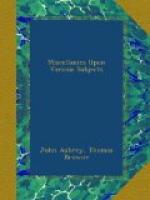The next remarkable thing that followed was, that on the third of June following;* Cornet Joyce carried King Charles I. prisoner from Holdenby to the Isle of Wight. The Isle of Wight lieth directly from Broad-Chalk, at the 10 o’clock point.
* See Sir W. Dugdale’s hist. of the Civil Wars.
The phaenomenon, fig. 2, was seen in the north side of the church-yard of Bishop-Lavington in Wiltshire, about the latter end of September 1688, about three o’clock in the afternoon. This was more than a semicircle. B. B. two balls of light. They were about eleven degrees above the Horizon by the quadrant; observed by Mr. Robert Blea, one of the Earl of Abingdon’s gentlemen.
Cicero de Natura Deorum, lib. 2. “Multa praeterea Ostentis, multa ex eis admonemur, multisque rebus aliis, quas diuturnus usus ita notarit, ut artem Divinationis efficeret”. i. e.
Besides, we learn a world of things from these Portents and Prodigies, and many are the warnings and admonitions we receive from them, and not only from them indeed, but from a number of extraordinary accidents, upon which daily use and constant observation has fixed such marks, that from thence the whole art of divination has been compounded.
Omens.
Before the battle at Philippi began, two eagles fought in the air between the two armies: both the armies stood still and beheld them, and the army was beaten that was under the vanquished eagle. See Appian’s Hist. part 2, lib. 4, g. 2.
It is worthy of notice, that, at the time the cities of Jerusalem and Antioch were taken from the Pagans, the Pope that then was, was called Urban, and the Patriarch of Jerusalem was called Eraclius, and the Roman Emperor was called Frederick; in like manner when Jerusalem was taken from the Christians by the siege of Saladin, the Pope was called Urban; the Patriarch of Jerusalem, Eraclius; and the Emperor, Frederick: and it is remarkable, that fourscore and seven years passed between these two events. Hoveden, f. 363.
Mathew Parker, seventieth Arch-Bishop of Canterbury, in the seventieth year of his age, feasted Queen Elizabeth on her birth day, 1559, in his palace at Canterbury. Parker. Vitae, 556.
It is a matter of notable consideration, says a Spanish historian, that the royal throne of the Morish Kings of Granada, began and ended in the times of the Fernandos of Castille: beginning in the time of Saint Fernando, the third of that name, and ending in that of the Catholic King, Don Fernando the fifth, his successor in the ninth descent. In the same manner, it is observable that the first Morish King was called Mahomad, and the last had the same name of Mahomad: which resembles what passed in the empire of Constantinople, where the first and last Emperors were called Constantines. Garibay, 1. 40, c. 43.
The same author mentions it as an extraordinary circumstance that, at one time lived in Castille, Arragon, and Portugal, three Kings called Pedros, and whose fathers were named Alonsos, who were also Kings at the same time. L. 14, c. 35.




